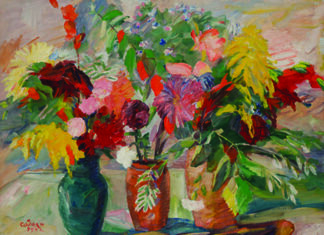LOS ANGELES (Los Angeles Times) — Charles Garabedian, modern artist of mythological themes, who was raised in East L.A., fought Air Force missions in World War II and studied history before his late-bloomer drift into painting, died last week at his Santa Monica home from prostate cancer, said his wife, Gwendolyn. He was 92.
Garabedian was known for bright, cannily cartoonish oil paintings in which scenes from Greek epics, even savage ones, were awash in cheerful color.
His work married wisdom with childlike innocence. The colors were pretty, the themes often dark.
The figures in his paintings wore enigmatic smiles. Dreamily entwined, or braced in ambiguous postures, their attitudes reflected Garabedian’s: “There are no absolutes,” he told a Times writer in 2011. “There is nothing you can really count on. And I think it’s better that way.”
The UCLA-trained Garabedian won a National Endowment for the Arts fellowship in 1977 and a Guggenheim fellowship three years later, and his work is included in numerous collections, including the Metropolitan Museum of Art and the Whitney Museum of American Art in New York and the Museum of Contemporary Art in Los Angeles.










